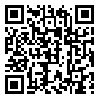BibTeX | RIS | EndNote | Medlars | ProCite | Reference Manager | RefWorks
Send citation to:
URL: http://jstnar.iut.ac.ir/article-1-3407-en.html
Accurate estimation of ET0 in any region is very important. The aim of this study is to compare and calibrate the 20 empirical methods of estimating evapotranspiration (ET0) based on three categories in monthly timescale at the Urmia Lake watershed. These categories are: 1) temperature-based models (Hargreaves (HG), Thornthwaite (TW), Blaney-Criddle (BC), Linacre (Lin)), 2) radiation-based model (the Doorenbos-Pruitt (DP), Priestly-Taylor (PT), Makkink (Mak), Jensen-Haise (JH), Turc (T), Abtew (A), McGuinness-Bordne (MB)) and 3) mass transfer-based model (Meyer (M), Dalton (D), Rohwer (R), Penman (P), Brockamp-Wenner (BW), Mahringer (Ma), Trabert (Tr), WMO and Albrecht (AL)). For this purpose, the information of 10 synoptic meteorological stations during the period of 1986-2010 was used. Results from the above mentioned methods were compared with the output of the FAO Penman-Monteith (PMF-56) method. Performance of the methods evaluated using the R2, RMSE, MBE and MAE statistics. The best and worst methods of each category were determined for the study area. The best methods of each category were calibrated for the area under study. Results indicated that there is a significant difference between the results of selected methods of each category and the PMF-56 method. Performance of the selected methods remarkably increased after calibration. Among the temperature-based group, the HG method having the median R2 value of 0.9597 was recognized as the best method. After calibration the medians of RMSE, MBE, and MAE were 72.09, 3.14 and 10.70 mm/ month, respectively. After HG, the Lin and BC found to be the best second and third methods in the study area. The TW showed Large error, therefore, it was not a suitable method for ET0 estimation in study area. Among the radiation-based group, the DP model was selected as the best method in the study area. Furthermore, the median of R2 values was 0.982. In this method, the medians of RMSE, MBE and MAE after calibration were 7.89. -0.62 and 6.03 mm/month, respectively. Following DP, the PT method was recognized as the 2nd best one. The methods namely M, JH, T, A and MB were put in the 3rd to seventh rank of the radiation category. Finally, among the mass transfer-based group, having R2=0.8945, the Meyer method was selected as the best method of this group for the study area. In the mentioned method (after calibration) the medians of RMSE, MBE, and MAE were 21.8, -8.7 and 17.3 mm per month, respectively. From mass transfer based group, the D method was found as the second best method in the study area. The methods namely R, P, BW, Ma, Tr, WMO and A were ranked 3rd to 7th, respectively. In general, the performance of radiation based methods was superior than others in Urmia Lake basin. Temperature based methods and mass transfer based methods were ranked second and third, respectively. Further examination of the performance resulted in the following rank of accuracy as compared with the PMF-56: DP (Radiation based), HG (Temperature based) and Meyer (Mass transfer). In general, it can be concluded that after calibration the DP method is suitable to estimate reference crop evapotranspiration among 20 selected methods in the Urmia Lake basin.
| Rights and permissions | |
 |
This work is licensed under a Creative Commons Attribution-NonCommercial 4.0 International License. |






